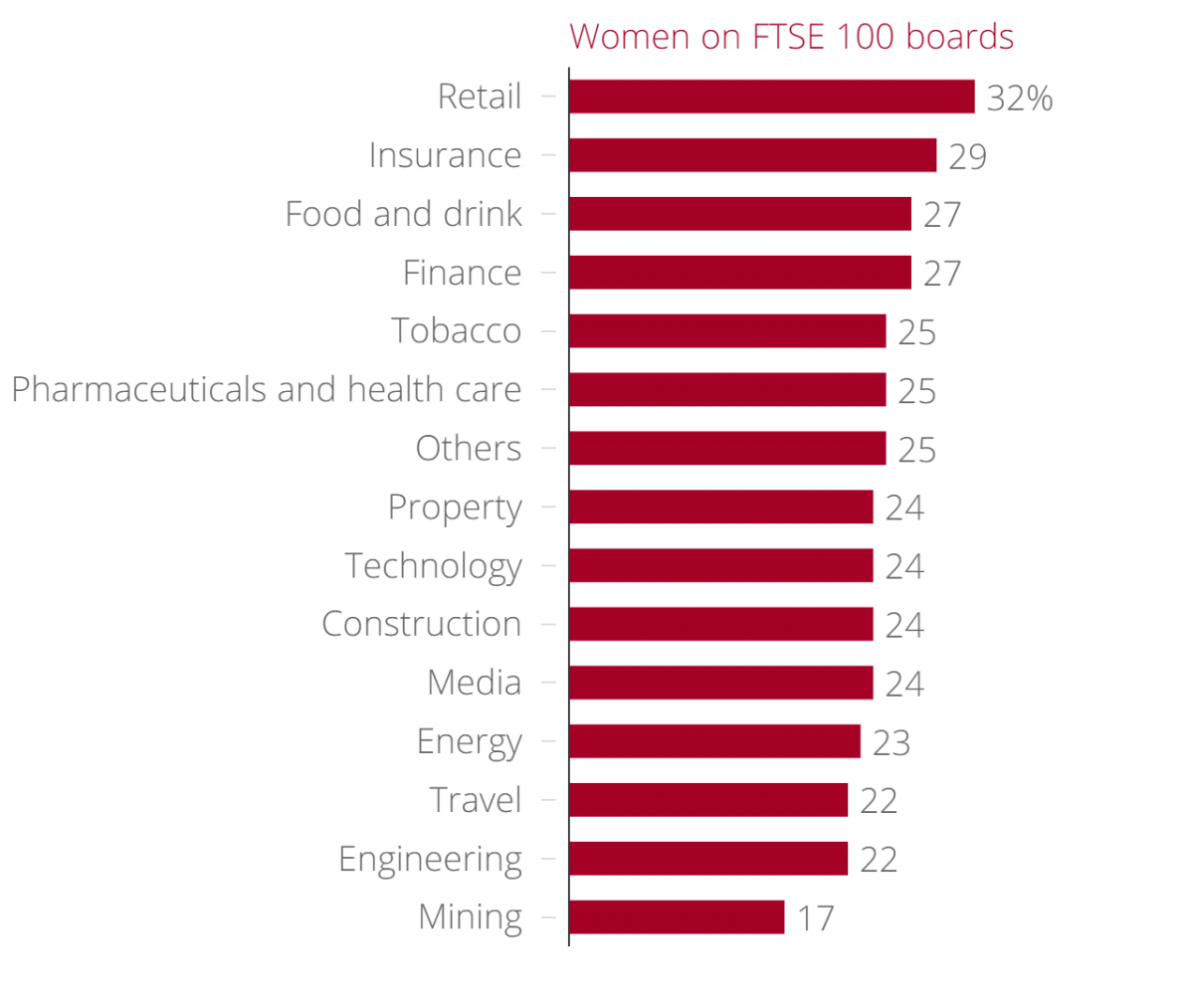mission et composition du conseil d’administration | Page 35
autres publications mission et composition du conseil d'administration
Femmes, CA et Grande-Bretagne : « Women on boards: 5 year summary »
Ivan Tchotourian 2 novembre 2015
En 2011, Lord Davies avait publié des recommandations pour accroître la proportion des femmes au sein des CA des entreprises de l’indice FTSE100 avec un objectif d’au moins 25 % de femmes à l’horizon 2015. Quel est le bilan ?
Positif, pardi ! En effet, un rapport publié le 29 octobre 2015 (« Women on boards: 5 year summary (Davies Review) », Department for Business, Innovation & Skills) démontre que l’objectif a été atteint.
There are more women on FTSE 350 boards than ever before, with representation of women more than doubling since 2011 – now at 26.1% on FTSE 100 boards and 19.6% on FTSE 250 boards. We have also seen a dramatic reduction in the number of all-male boards. There were 152 in 2011. Today there are no all-male boards in the FTSE 100 and only 15 in the FTSE 250.
Parmi les 5 recommandations faites pour le futur, signalons :
- The national call for action and voluntary, business-led approach is continued for a further five year period, ensuring substantive and sustainable improvement in women’s representation on Boards of FTSE 350 companies into the future
- Increasing the voluntary target for women’s representation on Boards of FTSE 350 companies, to a minimum of 33% to be achieved in the next five years.
- All stakeholders to work together to ensure increasing numbers of women are appointed to the roles of Chair, Senior Independent Director and into Executive Director positions on Boards of FTSE 350 companies.
- All FTSE Listed companies now assess the gender balance on their Boards and take prompt action to address any shortfall
À la prochaine…
Ivan Tchotourian
engagement et activisme actionnarial Gouvernance mission et composition du conseil d'administration
CA, composition et Volkswagen
Ivan Tchotourian 14 octobre 2015
Le New York Times offre un magnifique article sur les liens entre le scandale Volkswagen et le rôle du conseil d’administration : « Problems at Volkswagen Start in the Boardroom » (24 septembre 2015).
Morceaux choisis :
One measure of Mr. Piëch’s influence: In 2012, shareholders elected his fourth wife, Ursula, a former kindergarten teacher who had been the Piëch family’s governess before her marriage to Ferdinand, to the company’s supervisory board.
Although many shareholders protested her lack of qualifications and independence, they have little or no influence. Porsche and Piëch family members own over half the voting shares and vote them as a bloc under a family agreement. Labor representatives hold three of the five seats on the powerful executive committee, and half the board seats are held by union officials and labor.
Of the remaining seats, two are appointed by the government of Lower Saxony, the northwestern German state that owns 20 percent of the voting shares. Two are representatives of Qatar Holding, Qatar’s sovereign wealth fund, which owns 17 percent of Volkswagen’s voting shares. Members of the Piëch and Porsche families hold three more seats, and a management representative holds another
À la prochaine…
Ivan Tchotourian
mission et composition du conseil d'administration
Retour sur le rôle de surveillant du CA
Ivan Tchotourian 8 octobre 2015
Bonjour à toutes et à tous, voici un intéressant billet tiré de les affaires sur le rôle de surveillant du CA et de l’importance de l’évaluer : « CA: le surveillant » (ici).
À la prochaine…
Ivan Tchotourian
autres publications mission et composition du conseil d'administration
ACVM : quelle conformité des entreprises avec le règlement 58-101 ?
Ivan Tchotourian 2 octobre 2015
Les Autorités canadiennes en valeurs mobilières (ACVM) ont publié le 28 septembre 2015 le résultat d’une enquête (Examen du personnel sur les femmes aux postes d’administrateurs et de membres de la haute direction – Conformité au Règlement 58‑101 sur l’information concernant les pratiques en matière de gouvernance (l’« Avis 58-307 ») : ici) réalisée auprès de 722 émetteurs inscrits à la Bourse de Toronto sur le respect des nouvelles obligations d’information au sujet de la représentation féminine au conseil d’administration et à la haute direction, à la suite de la mise en oeuvre depuis le 31 décembre 2014 des modifications au Règlement 58-101 sur l’information au sujet des pratiques en matière de gouvernance.
Qu’y apprend-t-on ?
- 51 % des entreprises n’auraient même pas une seule femme à leur CA
- 49 % comptent au moins une femme au CA
- 40 % n’auraient même pas une seule femme au sein de leur haute direction.
- 60 % comptent au moins une femme à la haute direction
- 15 % ont ajouté une femme ou plus au conseil au cours de l’exercice.
L’examen a également révélé que la taille et le secteur d’activité des émetteurs étaient les indicateurs les plus significatifs de l’adoption ou non par ceux-ci de mesures visant à accroître la représentation féminine au conseil ou à la haute direction.
Par contre, sur la période du 31 décembre 2014 au 31 mars 2015, environ 14 % des émetteurs de l’échantillon avaient adopté une politique écrite pour identifier et nominer des administratrices. Parmi eux, seulement 47 % avaient établi des cibles spécifiques en matière de femmes administratrices.
À la prochaine…
Ivan Tchotourian
mission et composition du conseil d'administration
Les pires secteurs de la féminisation des CA
Ivan Tchotourian 1 octobre 2015
Vous êtes curieux de savoir quels sont les pires secteurs d’activité pour la féminisation des CA ? Je vous renvoie à cet article de Clara Guibourg du journal londonien CityA.M. : « Worst sectors for boardroom diversity: Women joining FTSE 100 boards but mining lags far behind retail industry as Conservatives push to end gender pay gapp ».
More women are joining the boards of Britain’s most powerful companies, but there’s a big difference between different industries, a breakdown by sector reveals. In a bid to end the gender pay gap « in a generation”, Prime Minister David Cameron announced plans today to require UK firms to publish gender pay audits. But progress is being made: last week FTSE 100 companies reached their target of 25 per cent female directors. But while retail companies have one-third female boards, mining companies land at just over half that, with 17 per cent women.
À la prochaine…
Ivan Tchotourian
mission et composition du conseil d'administration
Mission du CA vis-à-vis du président
Ivan Tchotourian 14 septembre 2015
Karen Higginbottom offre un bel article dans le magazine Forbes intitulé « The Role Of The Board In Appointing And Dismissing The CEO ». À cette occasion, l’auteure revient sur l’un des rôles les plus importants du conseil d’administration : nommer et révoquer le président du conseil (mission sur laquelle le droit et les codes de gouvernance ne précisent peu de choses).
On July 8 this year, Barclays announced that Anthony Jenkins, who had been brought into the bank as chief executive three years before to instigate a culture change was being sacked. The non-executive directors led by Sir Michael Rake, deputy Chairman and senior independent director explained that “new leadership was required to accelerate the pace of executive going forward and that John McFarlane was ideally qualified in this respect until a permanent successor was appointed.” Barclays denied that Jenkins’s sacking signaled any major change in strategy.
The whole incident brings into question the role of the board and Chairman (and on rare occasions, Chairwoman) in selecting and dismissing the CEO. The U.K. Corporate Governance Code sets out a code of conduct for the Chairman and non-executive directors of publicly listed companies in the UK. However, this code isn’t legally binding and is based on a “comply or explain” approach. The code by the Financial Reporting Council states that the board should “set the company’s strategic aims, ensure that the necessary financial and human resources are in place for the company to meet its objectives and review management performance.”
The most important job of the board is to decide whether a CEO’s time is up or not, remarks Andrew Campbell, director at Ashridge strategic management center. “Inevitably, one goes down a slippery slope as you have more discussions with directors as to whether the time is right for them to go and somebody calls a vote of no confidence and you either vote for or against the person.
À la prochaine…
Ivan Tchotourian


